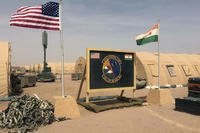 In a major boost for military tilt-rotor aircraft, the Navy has a preliminary agreement to buy MV-22 Ospreys to replace the aging C-2A Greyhound fixed-wing turboprops for the delivery of supplies and personnel to carriers.
In a major boost for military tilt-rotor aircraft, the Navy has a preliminary agreement to buy MV-22 Ospreys to replace the aging C-2A Greyhound fixed-wing turboprops for the delivery of supplies and personnel to carriers.
Navy Secretary Ray Mabus was expected to outline the Osprey deal in remarks Thursday to the Surface Navy Association National Symposium in Arlington, Virginia, a Navy spokesman said.
The agreement was first reported by Breaking Defense’s Richard Whittle, author of “The Dream Machine: The Untold History of the Notorious V-22 Osprey.”
The report said that Mabus, Chief of Naval Operations Adm. Jonathan Greenert, and Marine Corps Commandant Gen. Joseph Dunford had reached a memorandum of understanding for the Navy to buy four Ospreys each year at about $68 million apiece from Fiscal Year 2018 to 2020 for carrier-on-board delivery (COD) flights.
The Navy-Marine Corps arrangement on the Ospreys will have to be approved by Congress in the Fiscal Year 2016 budget for the Defense Department, which was expected to be submitted early next month.
The memorandum of understanding said that the “the Navy is responsible for modifying these V-22s into an HV-22 configuration,” the Navy’s variant of the MV-22 Osprey flown by the Marines. The CV-22 is the Air Force version of the Osprey.
The C-2As began flying in the 1960s to carry mail, personnel and supplies between the carriers and shore. The Ospreys, built by Bell Helicopter Textron Inc. and Boeing Co., went into service with the Marines in 2007 and with the Air Force in 2009.
The Osprey program began in the 1980s to replace the Marines’ aging CH-46 helicopters and was marred by several accidents in testing that resulted in 30 deaths – most of them Marines. At one point, former Defense Secretary Dick Cheney tried to kill the Osprey program by canceling funding, but his move was rejected by Congress.
The Ospreys’ two large wingtip rotors can rotate to enable it to take off and land like a helicopter and fly straight like a conventional fixed-wing aircraft.
In the past, the Army rejected the tilt-rotor concept but the service of the Ospreys in Iraq and Afghanistan has altered the Army’s philosophy. The Army’s Future Vertical Lift program now features several tilt-rotor designs.
In an effort to keep the Osprey production line open, the Marines and Bell Helicopter have been pushing foreign sales. Several nations have expressed interest in the Ospreys but not deals have yet been finalized.








